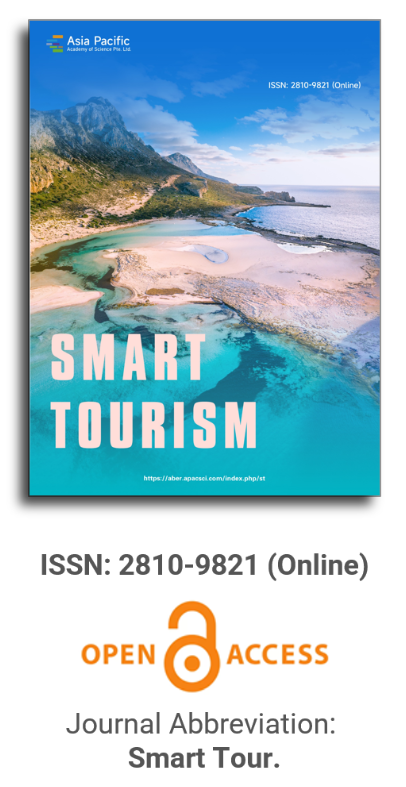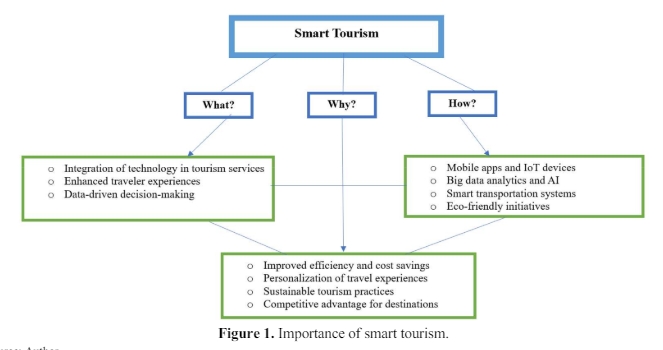


Intelligent tourism route optimization based on teaching and learning optimization algorithm
Vol 2, Issue 2, 2021
Download PDF
Abstract
According to the principles of tourism route design and the needs of tourists, the teaching and learning optimization algorithm was improved, and a tourism route optimization method based on the improved teaching and learning optimization algorithm was established. The optimization test of travel routes in Hanzhong area shows that the tourism routes designed by using this algorithm are feasible and efficient, and it has certain practical value for tourism traffic planning, tourism routes design, especially for self-driving tourists to carry out efficient tourism activities.
Keywords
References
- Pang Y. Tourism development and tourism geography. Beijing: Tourism Education Press; 1989.
- Campbell CK. An approach to research in recreational geography. British Columbia: University of British Columbia; 1967. p. 32–37.
- Lundren JOJ. The development of tourist travel system: A metropolitan economic hegemony par excellence. Jahrgang: Jahrbuch fur Fremdenverkegr; 1972. p. 62–65.
- Stewart SI, Vogt CA. Multi-destination trip patterns. Annals of Tourism Research 1997; 24(2): 458–461.
- Chu Y. Research on tourism route design. Tourism Tribune 1992; 7(2): 9–13.
- Wu K. Operational research on tourism route design and optimization. Tourism Science 2004; 18(1): 41–44.
- Ma X. Research on tourism route orphy and Geo-Information Science 2005; 21(2): 98–101.
- Fu J, Zheng Z, Gao J. Application of GIS technology in tourism route design. Journal of Shanghai Normal University: Natural Science Edition 2006; 5(3): 92–97.
- Wu C, He Y. Data mining and its application in tourism route planning system. Computer Technology and Development 2008; 18(9): 35–38.
- Pan Y, Liang Q. Tourism route optimization based on genetic algorithm. Journal of Zhejiang Normal University: Natural Science 2011; 34(3): 349–354.
- Teng C, Cao W. Selection and combination of tourist attractions and optimization algorithm and application of tourist routes. Journal of Geographical Information Science 2010; 12(5): 668–673.
- Geng J, Wu D, Ye Q, et al. Research on tourism route evaluation and optimization based on graph theory in Tibet. Areal Research and Development 2011; 30(1): 104–109.
- Rao RV, Savsani VJ, Vakharia DP. Teaching-learning-based optimization: A novel method for constrained mechanical design optimization problems. Computer-Aided Design 2011; 43(3): 303–315.
- Rao RV, Savsani VJ, Vakharia DP. Teaching-learning-based optimization: An optimization method for continuous non-linear large scale problems. Information Sciences 2012; 183(1): 1–15.
- Rao RV, Patel V. Multi-objective optimization of heat exchangers using a modified teaching-learning-based optimization algorithm. Applied Mathematical Modelling 2013; 37(3): 1147–1162.
- Rao RV, Patel V. Multi-objective optimization of two stage thermoelectric cooler using a modified teaching-learning based optimization algorithm. Engineering Applications of Artificial Intelligence 2013; 26(1): 430–445.
- Rao RV, Savsani VJ, Balic J. Teaching-learning-based optimization algorithm for unconstrained and constrained real-parameter optimization problems. Engineering Optimization 2012; 44(12): 1447–1462.
- Ahmend ZH. Genetic algorithm for the traveling salesman problem using sequential constructive crossover operator. International Journal of Biometrics & Bioinformatics (IJBB) 2010; 3(6): 96.
- Martinovic G, Bajer D. Impact of double operators on the performance of a genetic algorithm for solving the traveling salesman problem. Swarm, Evolutionary and Memetic Computing. Berlin: Springer Berlin Heidelberg; 2011. p. 290–298.
- Herrera F, Lozano M, Sanchez AM. Hybrid crossover operators for real-coded genetic algorithms: An experimental study. Soft Computing 2005; 9(4): 280–298.
- Hanzhong Statistics Bureau. Hanzhong 2013 statistical bulletin of national economic and social development [Internet]. 2014 Jun 20. Available form: http://tjj.hanzhong.gov.cn/tjgb/tjgb2014.HTM.
Supporting Agencies
Copyright (c) 2021 Hong He, Gennian Sun
License URL: https://creativecommons.org/licenses/by/4.0

This site is licensed under a Creative Commons Attribution 4.0 International License (CC BY 4.0).

Prof. Hung-Che Wu
Nanfang College, Guangzhou
China
Indexing & Archiving
Asia Pacific Academy of Science Pte. Ltd. (APACSCI) specializes in international journal publishing. APACSCI adopts the open access publishing model and provides an important communication bridge for academic groups whose interest fields include engineering, technology, medicine, computer, mathematics, agriculture and forestry, and environment.



.jpg)
.jpg)

.jpg)

